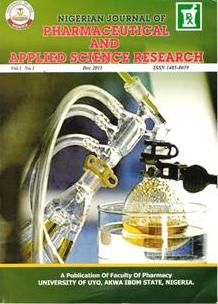Toxicological Effects of Polyacrylate-Based Eyelash Glue on Tear Cytokine Levels: A Quasi-Experimental Study
Main Article Content
Abstract
Background: Polyacrylate-based eyelash glue, widely used for aesthetic eyelash extensions, may pose ocular health risks by altering tear cytokine levels. This study aimed to evaluate its toxicological effects on tear cytokines in young Nigerian women.
Methods: A quasi-experimental study involved 10 healthy females (aged 18–24 years) with no prior glue exposure. Tear samples, collected at baseline and after one month of daily polyacrylate-based glue application, were analysed for IL-1?, IL-6, and IL-10 levels using ELISA. Paired t-tests and ANOVA assessed changes (p < 0.05).
Results: IL-6 levels significantly decreased from 35.45 ± 21.31 pg/ml to 8.21 ± 4.31 pg/ml (p = 0.0028; ANOVA p = 0.000914). IL-1? (338.64 ± 174.69 to 230.02 ± 109.49 pg/ml, p = 0.1163) and IL-10 (44.13 ± 27.52 to 40.01 ± 12.31 pg/ml, p = 0.6736) showed non-significant reductions. Conclusion: Polyacrylate-based eyelash glue selectively suppresses tear IL-6, potentially increasing ocular infection risk, necessitating safer adhesives and stricter cosmetic regulations in Nigeria.
Keywords: cosmetic safety, eyelash extensions, ocular immunology, polyacrylate adhesive, tear cytokines
Downloads
Article Details

This work is licensed under a Creative Commons Attribution-NonCommercial-NoDerivatives 4.0 International License.
References
Abah ER, Oladigbolu KK, Rafindadi AL, Audu O. Eyelash extension use among female students in a tertiary institution in Nigeria: A study of Kaduna Polytechnic, Kaduna. Niger J Clin Pract 2017;20(12):1639–1643.
Bergmann M, Mützel S, Primpke S, Tekman MB, Trachsel J, Gerdts G. White and wonderful? Microplastics prevail in snow from the Alps to the Arctic. Sci Adv 2019;5(8):eaax1157.
Enríquez-de-Salamanca A, Castellanos E, Stern ME, Fernández I, Carreño E, García-Vázquez C, Herreras JM, Calonge M. Tear cytokine and chemokine analysis and clinical correlations in evaporative-type dry eye disease. Mol Vis 2010;16:862–873.
Goto E, Endo K, Suzuki A, Fujikura Y, Matsumoto Y, Tsubota K. Tear evaporation dynamics in normal subjects and subjects with obstructive meibomian gland dysfunction. Invest Ophthalmol Vis Sci 2003;44(2):533–539.
Kanlayavattanakul M, Lourith N. Periocular dermatitis induced by eyelash adhesives: An emerging cosmetic concern. Contact Dermatitis 2015;72(1):52–58.
Kim MJ, Kim JH, Seo KY. Acrylate exposure induces apoptosis and oxidative stress in human corneal epithelial cells. Toxicol In Vitro 2017;42:258–265.
Koffour GA, Anto BP, Afau C, Kyei S, Gyanfosu L. Ocular discomforts following eyelash extension. J Med Biomed Sci 2012;1:55–61.
Lemp MA. Advances in understanding and managing dry eye disease. Am J Ophthalmol 2008;146(3):350–356.
Nguyen MT, Vingrys AJ, Bui BV. Proinflammatory cytokine release in response to chemical irritation of the ocular surface. Invest Ophthalmol Vis Sci 2019;60(4):1234–1240.
Pflugfelder SC, Stern ME, Beutler B. Cytokine regulation in the ocular surface: Its role in allergic and inflammatory eye disease. Allergy Asthma Proc 2008;29(5):465–472.


